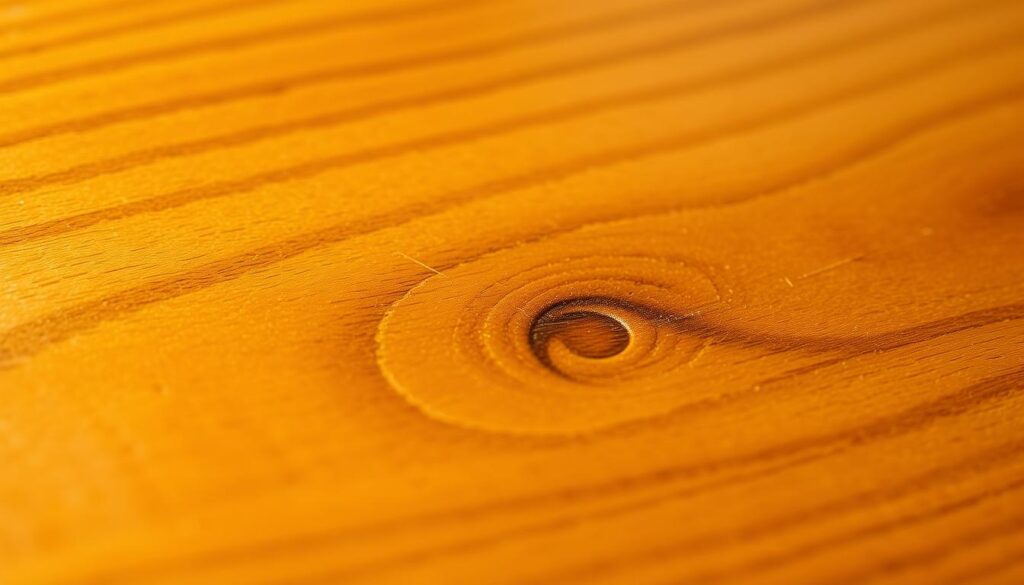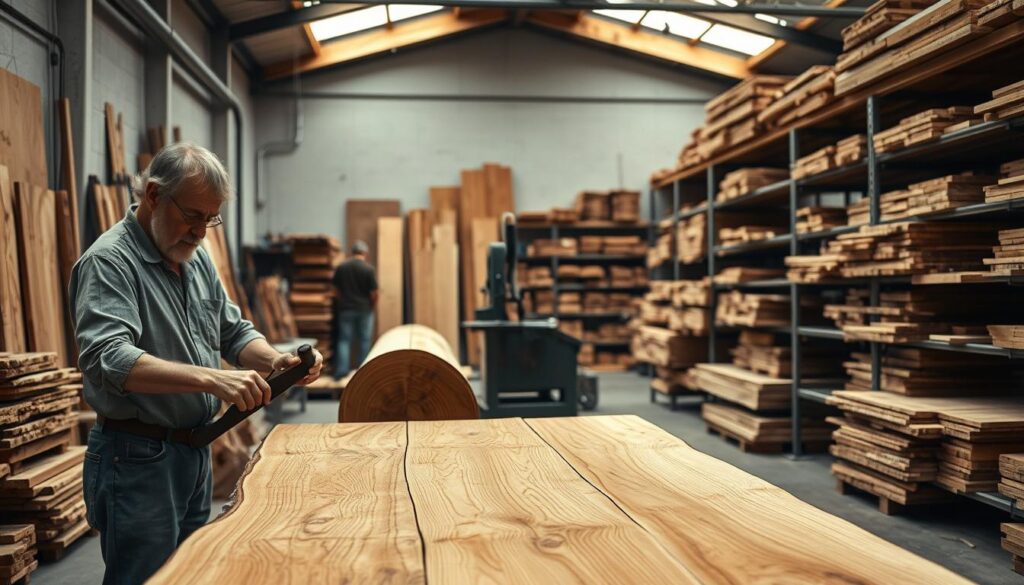Understand the distinctive look and qualities of teak wood. Explore the features that make this lumber a popular choice for various applications.
Teak wood is highly valued for furniture and building. It’s known for being durable and having a beautiful look. Knowing what makes teak wood special helps us see its worth and uses. It’s a favorite for outdoor furniture and home decor.

The look of teak wood is unique, with a special grain and color changes. This makes it stand out. Learning about teak wood helps us choose the right material for our projects. Its lasting quality is perfect for outside, and its beauty works well inside.
Key Takeaways
- Teak wood is a durable and attractive material for furniture and construction
- Understanding teak wood characteristics is essential for appreciating its value and versatility
- Teak wood appearance is characterized by its distinctive grain pattern and natural color variations
- Teak wood is a popular choice for outdoor furniture and interior design projects
- Teak wood’s durability and resistance to weathering make it an excellent choice for various applications
- Exploring teak wood characteristics helps individuals make informed decisions when selecting materials for their projects
Understanding Teak Wood’s Natural Appearance
Teak wood is known for its unique golden-brown color. This color can change based on the tree’s age and where it grows. Each piece of teak wood has its own special look, thanks to these color changes.
The look of teak wood also comes from its grain patterns and texture. Its grain can be straight, wavy, or irregular, making it interesting to look at. The texture is smooth, with a fine grain that doesn’t warp or crack easily.
Natural Color Variations
Teak wood’s colors are one of its most striking features. The heartwood, the older, denser wood at the tree’s center, is darker and richer. This contrasts with the sapwood, the younger, lighter wood near the edge. This contrast creates a beautiful, mottled look that woodworkers love.
Grain Patterns and Texture
The grain and texture of teak wood are key to its look. Its grain is long and straight, running parallel to the tree’s length. The texture is smooth and even, with a soft, velvety feel.
Surface Characteristics
The surface of teak wood is also important. It has a naturally oily surface that resists moisture and decay. This makes it perfect for outdoor use. The surface can be smooth or rough, depending on the type of teak wood and how it’s processed.
| Characteristics | Description |
|---|---|
| Color | Golden-brown, with variations in intensity |
| Grain Pattern | Straight, with occasional waves or irregularities |
| Texture | Smooth, with a fine, even grain |
The Distinctive Features of Raw Teak Wood
Raw teak wood is highly valued for outdoor furniture and building. It naturally resists rot and insect damage. Its grain pattern, from straight to wavy, and coarse texture make it a favorite among builders.
The wood’s natural oil content impacts its finish and durability. Teak wood features like this oil content also prevent warping and cracking. This ensures outdoor structures stay stable and secure. Craftsmen use special techniques and finishes to highlight its beauty.
Using raw teak wood offers many benefits. It’s durable, easy to maintain, and looks great. Here are some tips for working with it:
- Use proper cutting and drilling techniques to avoid splintering or cracking
- Apply a suitable finish to protect the wood from the elements
- Regularly clean and maintain the wood to prevent dirt and debris buildup
Understanding raw teak wood’s unique features helps builders create stunning outdoor spaces. Its grain, texture, and oil content make it perfect for lasting, beautiful outdoor areas.
What Does Teak Wood Look Like When First Cut?
Teak wood fresh cut has a unique look that stands out. At first, it looks pale and rough, with a coarse texture. But as it dries and ages, it develops a warm, rich glow that woodworkers love.
The initial look of teak wood is pale yellow or brown. Over time, it darkens to deep brown or golden brown. This change is due to its high oil content, which protects it and adds a sheen. As it ages, the surface texture becomes smoother and more even.
Fresh Cut Appearance
When teak wood is first cut, it’s rough and uneven. It also has a strong, unpleasant smell from its high oil content. But as it dries, the smell fades, and the texture becomes smoother, making it easier to work with.
Initial Color Properties
Teak wood starts off pale yellow or brown. Over time, it darkens to deep brown or golden brown. This color change is due to its high oil content, which protects it and adds a sheen.
Video source from Youtube
Surface Texture Changes
As teak wood ages, its surface texture changes. It becomes smoother and more even as it dries and hardens. It may also develop a subtle sheen or glow from its high oil content. The initial appearance of teak wood is just the start of its transformation into a beautiful, durable material.
| Characteristics | Fresh Cut | Aged |
|---|---|---|
| Color | Pale yellow or brown | Deep brown or golden brown |
| Texture | Rough, uneven | Smooth, even |
| Odor | Strong, unpleasant | Mild, pleasant |
How Teak Wood Ages and Weathers
Teak wood is known for its durability and ability to withstand harsh weather conditions. Over time, it ages and weathers, changing its color and texture. When exposed to sunlight, it develops a silvery-gray patina. This is due to the wood’s natural oils reacting to the sun’s ultraviolet rays.
Teak wood weathering is also influenced by moisture and temperature changes. In humid environments, it may darken and become richer. In dry environments, it may lighten and become more prone to cracking. Regular maintenance is key to prevent damage and keep the wood looking its best.
Several factors affect teak wood aging and weathering:
- Exposure to direct sunlight
- Humidity and moisture levels
- Temperature fluctuations
- Quality of the wood and its initial treatment
Understanding teak wood aging and weathering is crucial for maintaining its beauty. By recognizing these effects, individuals can protect and preserve their teak wood products. This ensures they remain beautiful and functional for years.
By embracing the natural aging and weathering of teak wood, individuals can appreciate its unique character and beauty. Each piece of teak wood becomes truly unique and valuable over time.
Identifying Quality Teak Wood
Quality teak wood is key for lasting furniture and building projects. Look for straight grain and consistent color to spot premium teak. It’s also important to check if the wood is genuine.
Watch out for knots, cracks, and warping in teak wood. These flaws can weaken the wood. High-quality teak, however, has a smooth texture and a warm, golden hue.
Premium Grade Indicators
- Straight grain
- Consistent color
- Smooth, even texture
Common Defects to Watch For
- Knots
- Cracks
- Warping
Authentication Methods
Verifying teak wood’s origin and quality is crucial. This can be done through visual checks, lab tests, and certifications from trusted bodies. This ensures the wood’s quality and authenticity.
Choosing reliable suppliers is vital when buying teak wood. They should offer certifications and guarantees. This way, you know the wood is genuine and of high quality. Prioritizing quality teak wood brings many benefits.
| Characteristic | Premium Grade Teak Wood | Lower Grade Teak Wood |
|---|---|---|
| Grain | Straight | Irregular |
| Color | Consistent | Variable |
| Texture | Smooth | Rough |
Teak Wood’s Unique Oil Content and Shine
Teak wood is known for its durability and resistance to the elements. This is thanks to its high oil content. The oil gives it a unique shine and protects it from moisture and UV light. This makes teak wood perfect for outdoor furniture and buildings.
The teak wood oil content is what makes it stand out. It repels water and prevents mold and mildew. To keep the teak wood shine, regular cleaning and protection are key.

- Natural resistance to moisture and UV light
- Low maintenance requirements
- Durable and long-lasting
The teak wood oil content and teak wood shine make it a great choice. It’s perfect for outdoor furniture, construction, and design.
Comparing Teak to Other Hardwoods
When we talk about teak wood comparison, it’s often compared to oak and maple. This is because they share similar density and grain patterns. However, teak wood has its own special traits and benefits.
One major difference in teak wood comparison is its color. Teak wood starts with a golden brown hue that deepens with age. In contrast, oak and maple tend to be lighter. Here are some main differences in a hardwood comparison:
- Color: Teak wood has a richer, darker color compared to other hardwoods.
- Texture: Teak wood has a coarse texture, while other hardwoods like oak have a smoother texture.
- Durability: Teak wood is highly durable and resistant to rot and insect damage, making it a popular choice for outdoor furniture.
In a teak wood comparison with other hardwoods, teak stands out. It may cost more, but its durability and resistance to damage are unmatched. When choosing a hardwood, it’s crucial to think about your project’s needs and preferences. This will help you pick the best wood for your project.
Regional Variations in Teak Appearance
Teak wood is grown in many places worldwide. Its look changes based on local weather and soil. The teak wood regional variations lead to color, grain, and texture differences. For example, Southeast Asian teak is often darker, while African teak is lighter and more golden.
When picking teak wood, think about its teak wood appearance and how it matches your style. Here are some things to keep in mind:
- Color: Teak wood colors vary from light golden to dark brown, based on where it’s from and how old it is.
- Grain pattern: Teak wood grains can be straight or wavy, depending on the region and tree type.
- Texture: Teak wood textures range from smooth to rough, varying by region and tree type.
Knowing about teak wood regional variations and teak wood appearance helps you choose the right teak wood for your project. By looking at the unique traits of teak wood from different areas, you can pick the perfect wood for your needs and style.
| Region | Color | Grain Pattern | Texture |
|---|---|---|---|
| Southeast Asia | Rich, dark brown | Straight to wavy | Smooth to rough |
| Africa | Light, golden brown | Wavy to curly | Rough to porous |
The Impact of Processing on Teak’s Look
Teak wood processing greatly changes how the wood looks. The methods used can make the wood look better or worse. It’s important to know the different techniques to pick the right one for your needs.
Finishing teak wood is a key step. The finish can change the wood’s color, texture, and how long it lasts. Proper finishing techniques can highlight the wood’s natural beauty. But, bad techniques can make it look dull and unattractive.
Milling Effects
Milling is a key part of processing teak wood. It can change the wood’s texture and look. For example, rough milling makes a textured surface, while smooth milling gives a sleek finish.
Finishing Techniques
There are many ways to finish teak wood, like staining and sealing or waxing and polishing. Each method can give a unique look and durability. The choice depends on how you plan to use the wood and what look you want.
Treatment Results
Teak wood treatments can also change its look. Chemical treatments can change the wood’s color and texture. Heat treatments can make the wood more durable and stable. Knowing about these treatments is key to getting the look you want.

By looking at milling effects, finishing techniques, and treatment results, you can choose the best way to process your teak wood. This is true for making furniture, flooring, or other items. Proper processing can make the wood look great and last a long time.
| Processing Method | Appearance | Durability |
|---|---|---|
| Rough Milling | Textured Surface | High |
| Smooth Milling | Sleek and Even Finish | Medium |
| Staining and Sealing | Enhanced Color and Texture | High |
Common Uses Based on Appearance
Teak wood is very versatile. It’s used for teak wood applications like outdoor furniture and interior design. Its natural colors and grain patterns make it popular for many projects.
Teak wood is great for furniture, construction, and decorations. Its durability and weather resistance are perfect for outdoor furniture. This includes patio sets and garden benches.
Choosing the right teak wood is key. You should look at the wood’s grade and processing level. Here are some tips for picking the best teak wood:
- Consider the color and grain pattern of the wood
- Check the grade of the wood and its level of processing
- Think about the intended use of the wood and its exposure to weathering
Understanding teak wood applications and its appearance helps you make the right choice. This way, you can pick the best teak wood for your project.
| Teak Wood Application | Description |
|---|---|
| Furniture making | Teak wood is often used for making outdoor furniture, such as patio sets and garden benches |
| Construction | Teak wood is used in construction for its durability and resistance to weathering |
| Decorative projects | Teak wood is used for decorative projects, such as wood carvings and wall paneling |
Maintaining Teak’s Visual Appeal
Teak wood is both valuable and durable. It needs regular care to keep its beauty and last longer. Cleaning, preserving, and restoring the wood are key steps. These can be done with various techniques and products, like teak wood preservation methods.
Keeping teak wood clean is crucial. Use a mild soap and water or a special cleaner. Avoid harsh chemicals and abrasive materials that can harm the wood. Applying a teak wood sealant or oil also helps protect it from the elements and damage.
Cleaning Methods
- Use a mild soap and water solution to clean the teak wood
- Avoid using harsh chemicals or abrasive materials
- Apply a teak wood cleaner or sealant to protect the wood
Preservation Techniques
Teak wood preservation means applying a protective coating or sealant. This prevents damage and decay. Use teak wood oils and sealants for this. Regular application keeps the wood looking good and lasts longer.
Restoration Tips
Teak wood restoration may be needed to fix damaged or worn areas. Techniques like sanding and refinishing can help. Always use proper preservation methods to protect the restored area and prevent more damage.
Conclusion
Teak wood is highly sought after for many reasons. Its natural colors and grain patterns are unique. It’s also very durable and has a high oil content.
Teak wood is perfect for both outdoor and indoor spaces. Its beauty and functionality are unmatched. It adds a special touch to any area.
When choosing teak, look for quality and authenticity. Premium-grade teak ensures your design lasts long. With the right care, teak’s beauty will last for years.
Teak wood brings natural elegance to your designs. It ranges from golden to silvery tones. This versatile material lets your creativity shine.
Teak wood is more than just a material. It’s a canvas for your vision. Let it elevate your spaces with its unmatched beauty and performance.
FAQ
What are the natural color variations of teak wood?
Teak wood has a unique golden-brown color. This color can change based on the tree’s age and where it grows. It can range from a light honey color to a deep, rich brown.
What are the common defects to watch for in quality teak wood?
Look out for knots, cracks, warping, and uneven grain patterns in quality teak wood. It’s important to check the wood carefully to ensure it’s durable and looks good.
How does teak wood’s oil content affect its shine and resistance?
Teak wood has a lot of natural oil. This oil makes it shiny and protects it from moisture and UV light. It’s this oil that makes teak wood so strong and resistant.
How does the processing of teak wood impact its appearance?
How teak wood is processed, like milling and finishing, can change how it looks. It’s important to use the right methods to bring out the wood’s natural beauty.
What are the common uses of teak wood based on its appearance?
Teak wood’s unique look makes it great for many uses. It’s used in furniture, building, and decorative projects. Its durability and beauty are perfect for both inside and outside spaces.
What are the key steps for maintaining teak wood’s visual appeal?
To keep teak wood looking good, clean it regularly and use preservation methods. Sometimes, you might need to restore it. Taking care of it properly can make it last longer and stay beautiful.
Read also : Elegant Outdoor Teak Wood Table for Backyard Entertaining
